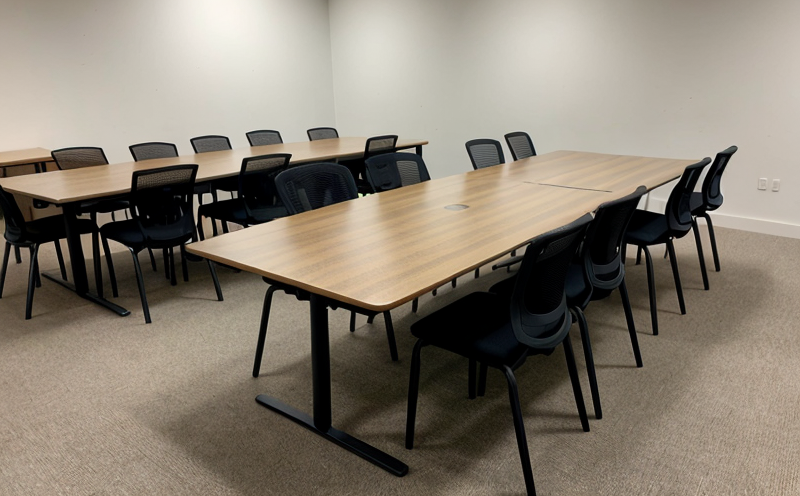ASTM F1912 Stability Testing for Desks and Classroom Tables
The ASTM F1912 stability test is a critical procedure used to ensure that desks and classroom tables are safe, durable, and capable of supporting the intended load without tipping over. This standard applies particularly to furniture designed for use in educational environments where children's safety is paramount. The test aims to simulate real-world conditions under which the furniture might be subjected to stress from various sources.
The primary objective of ASTM F1912 testing is to evaluate the stability and structural integrity of desks and classroom tables, ensuring that they remain upright when placed in use or storage. This involves assessing how well the furniture handles both static loads (such as books or personal items) and dynamic loads (like a student leaning on it). The test ensures that the furniture meets rigorous safety standards set by ASTM International.
During testing, specimens are subjected to load application at different points along their surface areas. This loading mimics typical usage scenarios where uneven weight distribution could occur. Specimens must also undergo tipping tests to confirm they do not tip over under these conditions. Compliance with this standard helps manufacturers meet regulatory requirements and gain market acceptance for their products.
The ASTM F1912 stability test is particularly important given the increasing awareness of product safety in education sectors worldwide. Many educational institutions now require furniture suppliers to provide certification that their products have passed such tests before being installed or used. By adhering to this standard, manufacturers can demonstrate their commitment to producing safe and reliable classroom furniture.
The testing procedure outlined in ASTM F1912 involves several key steps:
- Preparation of the specimen according to specified dimensions and configurations
- Loading the specimen with weights at specific intervals across its surface area
- Measuring displacement or tipping angles during load application
- Evaluating whether the specimen remains stable under all tested conditions
This detailed approach ensures that every aspect of the furniture's stability is thoroughly examined. For instance, when preparing specimens, precise measurements and materials must be used to ensure accurate test results. Loading should follow standardized procedures to replicate real-world usage accurately.
The importance of ASTM F1912 testing cannot be overstated in maintaining high standards of safety and reliability in educational furniture. By ensuring that desks and classroom tables meet these stringent criteria, manufacturers contribute significantly to creating safer learning environments for students.
Why Choose This Test
Selecting ASTM F1912 stability testing for your furniture ensures compliance with industry standards, enhances product safety, and builds trust among customers. Here are some compelling reasons to opt for this service:
- Regulatory Compliance: Meeting ASTM F1912 requirements demonstrates adherence to recognized international standards, which is crucial for global market entry.
- Safety Assurance: Ensuring that furniture does not tip over under typical usage conditions significantly reduces the risk of accidents and injuries.
- Customer Satisfaction: Providing safe, durable products fosters long-term relationships with clients and enhances brand reputation.
- Market Edge: Offering certified stability-tested furniture can set your business apart from competitors by emphasizing quality and safety.
In today’s competitive landscape, these benefits make ASTM F1912 testing an indispensable part of any manufacturer's quality assurance process. Whether you're a small startup or a large enterprise, this service helps ensure that every piece of furniture meets the highest standards of safety and reliability.
Customer Impact and Satisfaction
The implementation of ASTM F1912 stability testing has numerous positive impacts on customers and stakeholders. For end-users like students, teachers, and parents, it translates into peace of mind knowing that the furniture they are using is safe and reliable. This assurance can lead to increased satisfaction and loyalty towards the brand.
For educational institutions, compliance with ASTM F1912 standards ensures that they are meeting health and safety regulations set by governing bodies. This not only protects them from potential legal issues but also enhances their reputation as providers of a safe learning environment.
From a procurement perspective, suppliers who offer ASTM F1912-certified products can streamline the purchasing process for educational institutions seeking reliable furniture solutions. The certification acts as a quality seal that simplifies decision-making and negotiation processes.
In summary, implementing ASTM F1912 stability testing goes beyond mere compliance; it represents a commitment to excellence in product design and manufacturing. It fosters customer trust, enhances stakeholder satisfaction, and positions suppliers as leaders in the industry.
International Acceptance and Recognition
The ASTM F1912 stability test enjoys widespread acceptance across numerous countries, reflecting its importance in ensuring product safety. Many nations have adopted this standard due to its rigorous nature and emphasis on real-world application.
In the United States, several states require furniture manufacturers to comply with ASTM standards for educational use. This includes California, which has stringent regulations regarding children's products. Similarly, European countries like Germany and France follow similar guidelines under their respective national standards that align closely with ASTM F1912.
The popularity of this test extends beyond North America and Europe. Countries in Asia such as Singapore and Japan also mandate adherence to international safety standards for classroom furniture. These regions recognize the value of ASTM F1912 in providing consistent, high-quality products capable of meeting diverse cultural needs.
Furthermore, many global organizations involved in education and child welfare advocate for the use of ASTM F1912 as a benchmark for quality assurance. This recognition underscores its significance in promoting safe learning environments worldwide.
The universal acceptance of ASTM F1912 highlights its role in fostering international cooperation and consistency in product safety standards. By aligning with this standard, manufacturers can tap into diverse markets while maintaining consistent quality across borders.





